Many digital marketers are looking for email deliverability services, because it’s not enough just to ensure that a message is sent, but it’s crucial to ensure that it reaches the recipients’ inbox and not the spam folder.
To achieve this goal, technical challenges must be overcome in order to ensure that emails are received as intended by the recipients.
This process, also known as “inbox placement”, involves a number of factors that will be explored throughout this article.
Table of Contents
What is deliverability?
Deliverability is one of the most important aspects when it comes to email marketing.
Basically, when we say that an email message has been delivered, we are only talking about the first part of a challenge, which is to overcome any blockages and have the email received by the email service provider.
The most important question here is: where was the email delivered? Our goal, of course, is to reach the inbox and avoid the spam folder anyway.
Deliverability is the ability of a sender to deliver emails in the best way for the recipients – and that includes overcoming delivery challenges and actually getting the emails to the inbox. This ability is called “inbox placement”.
What are the deliverability aspects considered by email providers?
In order to determine the destination of a sender’s email messages (blocking or delivery, inbox or spam folder), ESPs carry out an evaluation based on various aspects that make up what we call reputation.
Let’s take a look at the characteristics investigated by the providers.
Authentications
Email authentications are techniques used to verify the legitimacy of the sender and ensure that an email is not altered during sending. They are essential in establishing the sender’s reputation and are required by email service providers.
The three most important authentications are: SPF, DKIM and DMARC.
SPF (Sender Policy Framework) defines which email servers are authorized to send emails on behalf of a domain, helping to combat spoofing.
DKIM (DomainKeys Identified Mail) is a key that is activated in your domain and is consulted by the provider when a message is received, allowing you to check that the email came from the declared domain and has not been altered.
DMARC (Domain-based Message Authentication, Reporting and Conformance) is a kind of combination of the two previous authentications, SPF and DKIM, which tells the destination servers what to do with messages sent by domains that don’t pass SPF and DKIM, and allows domain owners to define policies on how unauthenticated emails should be handled.
Without them, the chances of having email marketing campaigns blocked by email service providers in their anti-spam filters greatly increase.
Daily email volume
Volumetrics is the aspect that deals with the quantity of emails sent to an email service provider in a given period. Sending large volumes of emails can be seen as suspicious behavior by ISPs.
For this reason, there is a technique called `warm up’, which manages sending volume in a careful way, sending emails consistently, but adding volume, creating a volume history with the providers.
This practice can help avoid blocks and improve the sender’s reputation.
Bounces
Bounces are emails that have not been delivered to their recipients. They can be of two types:
- Soft bounces: delivery failures of a temporary, reversible nature. Emails with soft bounces are usually returned due to connection failures, full boxes, blockages, unavailable servers, etc.
- Hard bounces: these are permanent, irreversible delivery failures. These emails can’t be delivered because they don’t exist, whether it’s a fault in the syntax of the email or a non-existent domain or user.
Managing bounces is also an extremely important aspect of ensuring the deliverability of email marketing campaigns. There is a double aspect to this analysis.
Soft bounces act as a thermometer: depending on the type of message returned by the ESP, it is possible to identify numerous faults that lead to blocks. For example, blocking messages contain messages such as warnings of daily volume exceeded, IP or domain blacklisted, high number of complaints, among others.
Soft bounce messages can then be used to solve a series of deliverability problems.
When it comes to hard bounces, you should always keep your contact list clean and up-to-date. Volumes of just 3% of hard bounces are enough to cause blocks and a drop in reputation with email providers, damaging deliverability.
Spamtraps
Spamtraps are email addresses created specifically to catch spammers. Of the existing types, we highlight the two main ones: pristine spamtraps and recycled spamtraps.
Pristine spamtraps are addresses created specifically to work as spamtraps. Therefore, they have never sent any messages, nor have they had any real users.
Recycled spamtraps, on the other hand, are legitimate email addresses that once had a real user, but were abandoned and reused as traps.
Those who adopt questionable contact list building practices, such as email scraping, email harvesting, list buying, among others, may end up with spamtrap addresses on their contact lists. Sending messages to these addresses is extremely damaging to the sender’s reputation.
Content
When we talk about the content of the email, we are referring to everything that surrounds the email: the sender, the subject line, the text, the images, links and any attachments.
All these aspects directly influence deliverability. Poorly formatted content, with suspicious links or words associated with spam, can be filtered out as spam. You need to build the layout of your email marketing avoiding these mistakes, such as subject lines written in capital letters, content entirely in images, links that point to blacklisted domains, among others.
For this reason, there are “anti-spam score” tests carried out only on the content of emails.
Complaints
Complaints are complaints from recipients who mark an email as spam. Every time a recipient thinks that the email you sent was unsolicited, uninteresting or inappropriate, they may click on the “mark as spam” option. And this has a negative effect on your reputation.

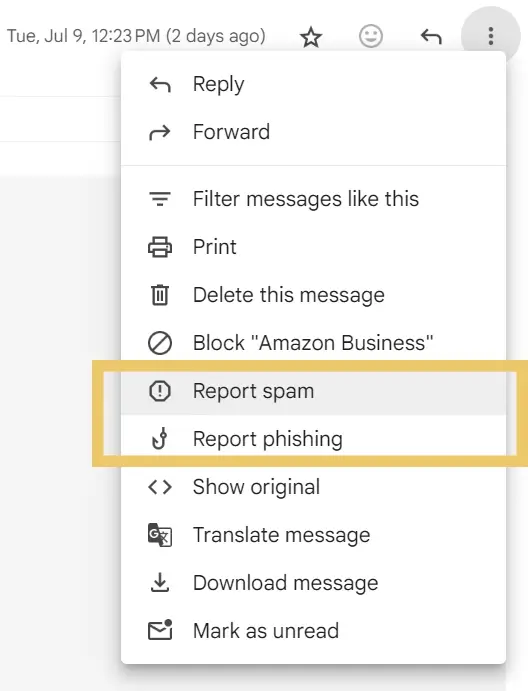
High complaint rates indicate that recipients are not interested in the emails or that the emails are unwanted. These complaint rates reduce the sender’s reputation score and can lead to blocking by email providers.
That’s why you should always try to respect your recipients by offering content that is relevant and appropriate to what has been offered, without abusing frequency or using clickbaits in subject lines, for example.
Engagement
This is one of the most important elements in building an email sender’s good reputation. Recipient engagement includes actions such as opening, clicking on and replying to emails. High levels of engagement indicate that recipients find emails valuable and relevant.
For this reason, maintaining high levels of engagement is fundamental to deliverability. Email providers monitor engagement to determine whether emails should be delivered to the inbox or filtered as spam.
Therefore, focusing on sending relevant content and segmenting contact lists can increase engagement and, consequently, deliverability.
How email deliverability services work
Email deliverability services are specialized solutions that aim to help companies improve their ability to deliver emails to recipients’ inboxes.
These tools monitor, analyze and demonstrate how to optimize various aspects of email delivery, as we’ll see below.
Sending IP reputation monitoring
This type of monitoring tracks the daily reputation score of sending IPs compared to the volume of emails sent by the IP. In this way, it is possible to observe when an IP’s score drops and establish correlations with other episodes, such as the volume of emails sent in a day or a specific campaign that was sent on a specific date.
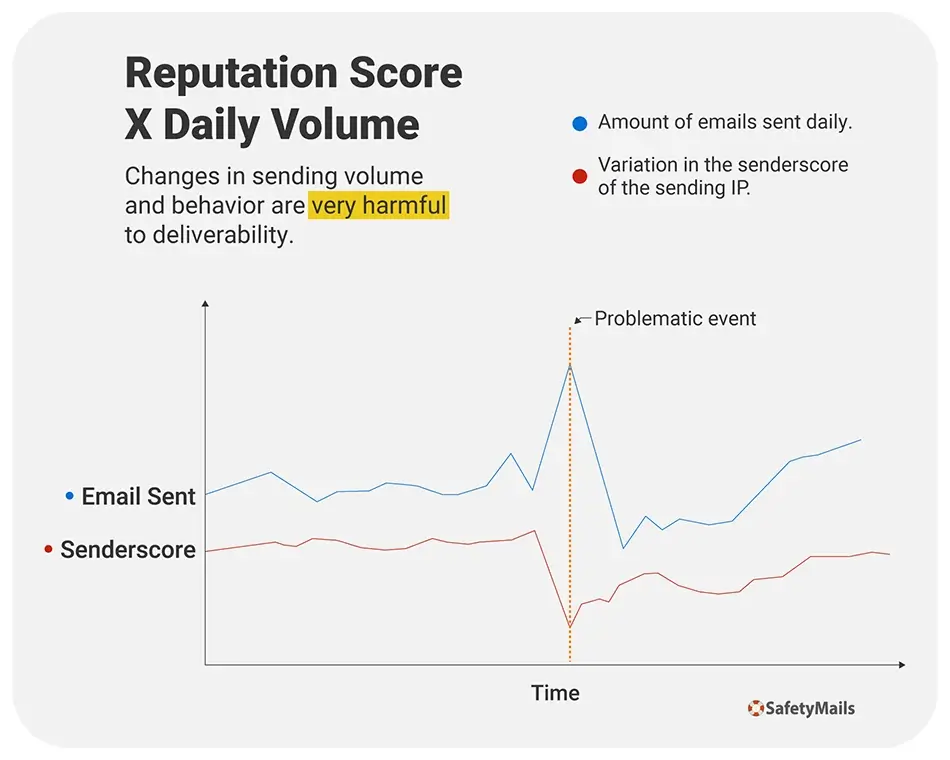
In the image above, for example, we can correlate the problematic event that caused the drop in senderscore with the sudden increase in sending volume. It could therefore be a warmup failure (daily volume exceeded) or even the use of a new, perhaps purchased, contact list.
Blacklist monitoring
Another management that deliverability services do (but which you can do manually) is blacklist monitoring.
Here, the sending IP address and domain are checked against the most important blacklisting services, such as URIBL, SURBL, Spamhaus, Spamcop and others.
When it is identified that an IP address or domain is listed, an alert is triggered on the monitoring platform.
However, you can do this quickly by accessing the blacklistalert.org service. Simply type in the IP address or domain and click on “check”. If you identify a problem, go to the blacklist service website and follow the steps to request removal (which can be simple or extremely complex, depending on the blacklist).
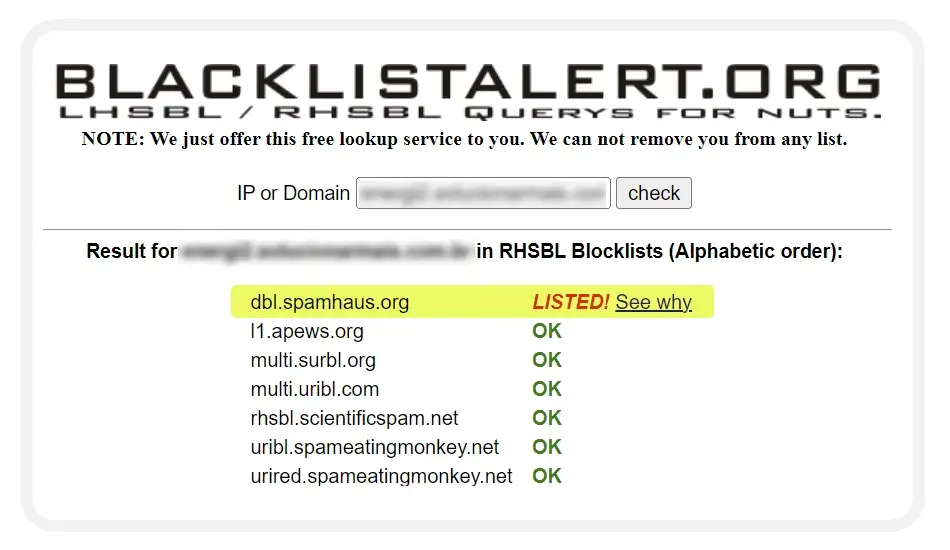
Content evaluation – rendering test
As we saw earlier, the content of your email marketing is fully monitored by anti-spam tools, whether it’s the subject line, the sender or the body of the message. Any aspect can trigger a blocking procedure.
Analysis and testing of anti-spam scores for content ensures that emails are not blocked or marked as spam because of their content.
Based on this score, deliverability service platforms offer suggestions for correcting or adapting elements, with the aim of reducing this score as much as possible and making the email free of suspicion.
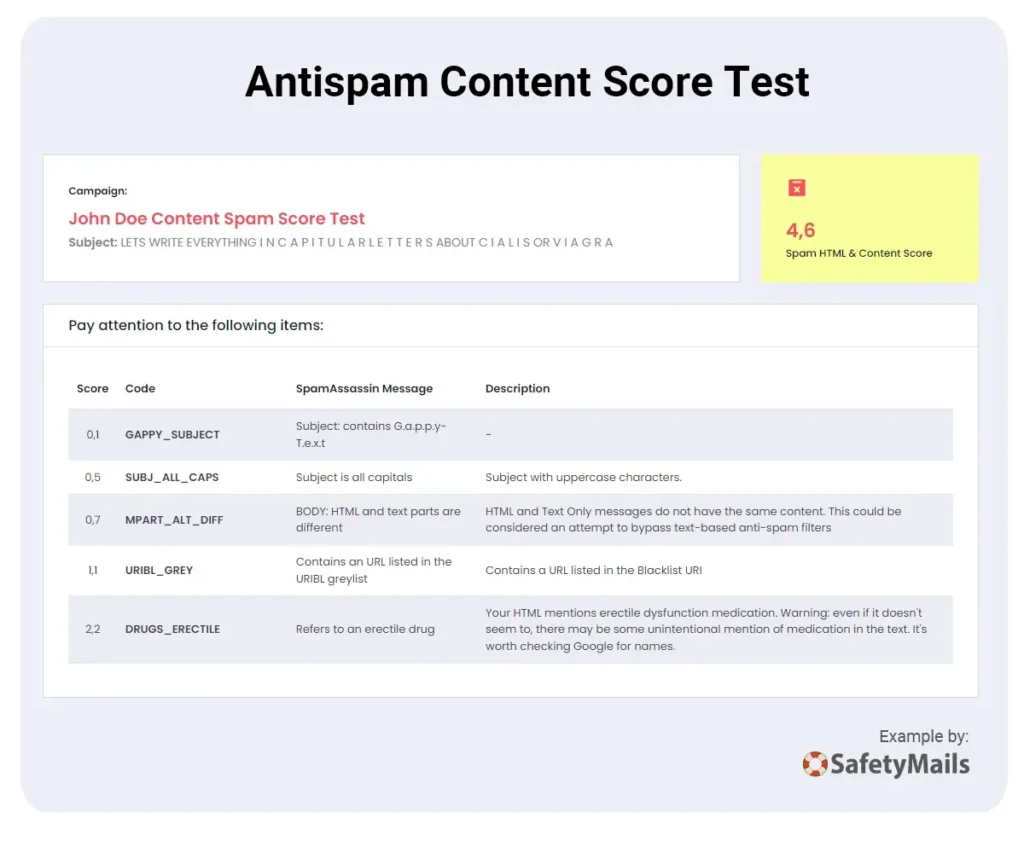
Inbox Placement Monitoring
The most classic test of email deliverability systems is inbox monitoring.
Through what has come to be called a “seed list“, platforms are able to map where email messages are delivered, offering an inference as to what the general delivery behavior of messages at email providers might be.
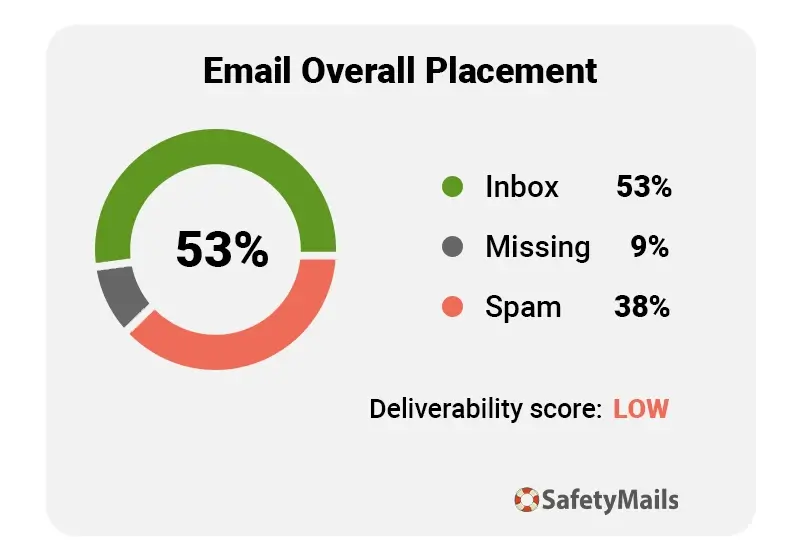
Tracking the history of email placement will give you an overview of deliverability: whether inbox placement is growing or declining.
Authentication monitoring
A simple report from these deliverability tools is the one related to email authentications – whether they are correctly configured or whether they need attention and repairs.
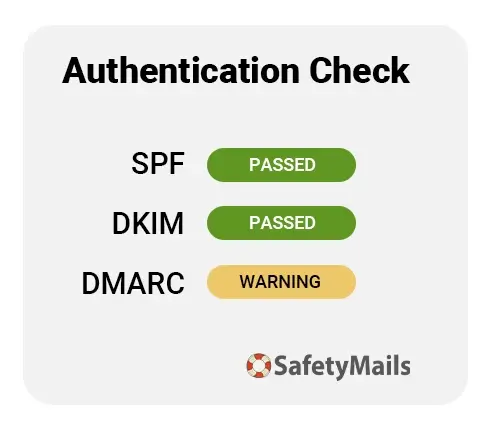
Benefits of deliverability services
Among the benefits that can be obtained with deliverability services are:
- Protection against block lists: constantly monitoring IPs and domains can prevent them from being blacklisted, or allow them to be quickly removed from them.
- Reduction in the number of bounces: with fewer problems that can cause blocks and fewer invalid emails, the number of bounces (hard or soft) is greatly reduced.
- Increased sender reputation: without blocks, with proper warmup and good sending practices, increased sender reputation is a good and expected consequence.
- Improved delivery rates: a good sender reputation, combined with well-targeted and segmented campaigns, leads to better delivery rates, deliverability and, ultimately, higher engagement rates.
Do you REALLY need a deliverability service?
When faced with the number of functionalities available and their promised benefits, it’s tempting to say that a deliverability service is necessary and even indispensable.
However, on closer inspection, practically all monitoring can be carried out without the aid of a dedicated tool.
Look: most email marketing platforms already offer anti-spam score analysis of content, as well as automatically offering SPF, DKIM and DMARC settings, and also comprehensive reports on the reasons for soft bounces and hard bounces.
In addition, the sending IP addresses in most email marketing tools are shared, i.e. the platforms themselves monitor them based on the collective behavior of customers allocated to an IP group.
Managing hard bounces can be done through a good internal policy for attracting new emails, as well as by hiring an email list cleaning service.
You can get an idea of inbox placement from engagement rates. As they improve, it’s a sign that the email marketing ecosystem as a whole is improving.
What’s more, if all the good email marketing practices are followed (which we explained in the section on deliverability aspects), the sender’s reputation will inevitably improve, making it unnecessary to have a platform just for this purpose.
However, if you are in a more complex email marketing context, with dedicated IPs, high sending volumes, integrations and advanced automations, then an email deliverability service may be indispensable.
In this case, follow some of the recommendations below.
How to choose a good deliverability service
- Reliability: having an email deliverability service is fundamental to improving email marketing results. However, what good is this type of email if its reports and monitoring are not accurate? In this way, the reports need to be extremely reliable so that the client is able to adopt the ideal measures for the greatest success of their email marketing campaigns.
- Ease of use: as a client, you already have a number of tasks relating to your digital marketing campaigns, especially email marketing. Hiring a new platform should be as easy as using it. There’s no point in looking for productivity in a service that will only increase your workload. That’s why it must be functional, practical and easy to use. Think about it.
- Customer support: Taking care of all aspects of deliverability, dealing with reports, making changes and improvements can be a complex process. Having customer support on hand to answer questions, seek guidance and provide operational assistance makes all the difference.
- Cost: there’s no point in investing in platforms and services and losing out on the ROI of digital marketing actions. That’s why the cost-benefit ratio needs to be interesting for the business and make email marketing more profitable, optimizing ROI.
Deliverability checklist
How about starting right now to improve the quality of your reputation and your relationship with email providers? Make a checklist of your email marketing best practices.
- ⬜ Authenticate your domain with SPF, DKIM and DMARC
- ⬜ Warm up your IP addresses
- ⬜ Monitor blacklists
- ⬜ Adopt good email capture practices, such as double opt-in
- ⬜ Don’t use purchased mailing lists
- ⬜ Make unsubscribing accessible and easy
- ⬜ Avoid questionable terms in your emails
- ⬜ Clean your email contact lists regularly
- ⬜ Segment your mailing lists
- ⬜ Send emails with interesting content that people want to engage with
- ⬜ Monitor the performance metrics of your campaigns (engagement)
Conclusion
Email deliverability is a determining factor in the success of email marketing campaigns. Ensuring that your emails reach the recipients’ inbox involves a series of practices and tools, from implementing authentications, managing volume and bounces, to creating relevant content and maintaining high levels of engagement.
Although many of these actions can be carried out in-house, specialized deliverability services can offer detailed monitoring and valuable insights.
Ultimately, the choice to use a deliverability service should be based on the complexity of your needs and the scale of your email marketing operations.
FAQ
Email deliverability refers to the ability to ensure that your emails reach the recipients’ inbox. This involves overcoming anti-spam filters and other barriers imposed by email service providers.
The most important authentications are SPF, DKIM and DMARC. They help to verify the legitimacy of the sender and ensure that emails have not been altered during sending, increasing the trust of email providers.
Sending large volumes of emails at once can be seen as suspicious behavior by email providers. Practices such as warm up, which gradually increase sending volume, help to build a positive track record and avoid blocks.
Soft bounces are temporary delivery failures, such as full inboxes or connection problems. Hard bounces are permanent failures, usually due to invalid or non-existent email addresses. Both must be monitored to keep the mailing list clean and up-to-date.
Spamtraps are email addresses created to catch spammers. Sending emails to spamtraps can result in blocks and damage to the sender’s reputation. Avoiding practices such as buying email lists helps prevent spamtraps from being sent.
Email content, including text, images, links and attachments, must be carefully formatted to avoid appearing suspicious or associated with spam. Anti-spam scoring tests can help ensure that the content is appropriate.
Complaints occur when recipients mark an email as spam. High complaint rates indicate that emails are unwanted, damaging the sender’s reputation and leading to blocking by email providers.
High levels of engagement, such as opens and clicks, indicate that recipients find emails valuable and relevant. Email providers monitor engagement to determine whether emails should be delivered to the inbox or filtered as spam. Sending relevant content and segmenting contact lists can increase engagement and improve deliverability.


